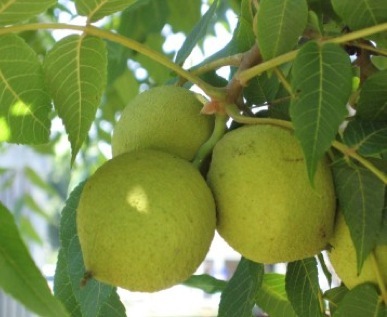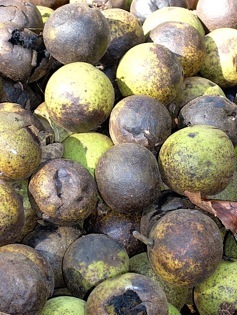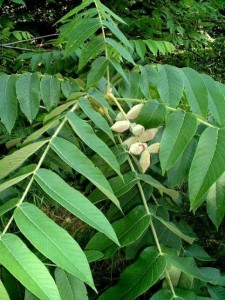Juglans nigra and butternut, too!

Black Walnut, Juglans nigra
I didn’t see my first Black Walnut tree until about 16 years ago. It so happened that the two places I lived the longest, Maine and Florida, are on both ends of the tree’s range. I lived a little north of the range and half a state south of the range.
However, I visited Alexandria, Virginia for an extended time and one day while jogging along a park trail there was a walnut tree covered with green mana. I went back later that same day and carried home all that I could carry (and did so for several weeks.) Then came the hard work. Walnuts are delicious, but they don’t give up easily.
The walnut most people buy are actually Juglans regia, (JEW-glanz REE-jee-uh) or “royal walnut.” They are also called English walnuts because English merchants popularized that particular nut, which is grown in the Balkans. You can find it from Greece to southwest China. The North American walnut, which is smaller and tougher to crack, is the Juglans nigra (JEW-glanz NYE-gruh), the Black Walnut.
Written references to the walnut are some 4,000 years old. About 1795 BC, Hammurabi mentioned them in a code of laws governing food. The Greeks were the first to systematically improve the species they got from Persia. The walnut is in Greek mythology in the story of Carya.
The god Dionysus (Dennis the Menace) fell in love with her. When she died, he changed her into a walnut tree. The goddess Artemis (Dianah) told Carya’s father the news and he ordered a temple be built in her memory. Its columns, sculpted from wood, were in the shape of young women. They were called catyatides, or nymphs of the walnut tree. Three famous stone Catyatides (and one cement substitute) are still standing at the Acropolis in Athens. Carya, incidentally, is the genus for hickories and pecans.
From Greece walnuts went to Rome around 100 BC and from Rome to Spain and France. When they got to England is a bit of a debate, from 400 AD to the 1400’s but the Old English name for walnut also started around 400 AD. The common walnut came to North America via the Spanish in California in the 1800’s. California leads the nation and the world in walnut production. Some 99% of the commercially purchased walnuts in the United States come from California, and 65%, almost two thirds of the walnuts consumed in the rest of the world come from California. The common walnut, J. regis, lives to about 60 and grow, on average, to 60 feet.

Black Walnut
The American native, the Black walnut, J. nigra grows from New England west to Minnesota south to the Gulf of Mexico and across northern Florida. It can grow to 60 feet and can live past 100 years. Black Walnut trees are more valued for their wood than their walnuts. However the walnuts are used in baking, ice cream, and candy. The walnuts can be shelled into large pieces if soaked overnight in water. The nutmeat is crunchy and spicy.
A favorite of my family was the Butternut or White walnut, J. cinerea. (JEW-glanz sin-EER-ee-uh.) It’s closely related to the black walnut and has oval-shaped nuts, with a thick shell with white kernels. The best flavored of the walnuts, it was prized in my family for homemade butternut ice cream. It was one of my mother’s joys in life. There was a butternut orchard nearby. The nuts are sticky, hull easily, and in three segments. And delicious. J. cinerea can grow to 100 feet and live around 75 years and is the most cold tolerant of the walnuts. Like black walnut trees, the roots of the Butternut tree release a phytotoxin that keeps many other plants from growing near it.
The Black Walnut is the most common walnut among foragers. They’re shaped like basketballs two inches in diameter and are usually ready for harvest in late summer or early fall. Try to get the nuts off the tree if possible, and good ones on the ground. Remove the husk and let the nut dry which “cures” it. After curing they can be stored shelled or unshelled. Two pounds of walnuts off the tree will produce about a cup of nutmeat.
To process them, first do with the walnuts what you do with acorns. Put them in water and discard any that float. Kernel quality can be ruined by insects; darker than usual husks may be evidence of insect damage. The water test gets rid of most but not all of the bad nuts. (Check those floating walnuts for edible grubs.)
Hulling walnuts is dirty, difficult work. A dye from the husk can stains your hands, clothes, tools and work surfaces. If the nuts are dry you can pound the hull side to side with a hammer. You can also use a cement mixer with three parts nuts to one part water plus a handful of gravel. Actually driving over them is dangerous in that the pressure can cause the nuts to pop out and hurt someone. Lastly, you can get a walnut sheller. After hulling, wash the unshelled nuts. Don’t compost the hulls because walnut hulls can suppress the grows of other plants. Tomatoes and apples, for example, won’t grow near walnuts.
After removing the husks walnuts have to be cured. Curing lets the walnut develop flavor. Stack the clean hulled nuts in shallow layers, put in a cool, dry, ventilated area out of sunlight for two weeks. A nut is cured when the kernel breaks crispy with a sharp snap. If you don’t cure them correctly they will mold. Store at 60F or less. Ideal humidity is 70%
When you’re ready to shell the walnuts, put them into hot tap water and soak for a day. Next day put them in hot tap water again for about two hours. Then shell. In a sealed jar in the refrigerator nutmeats can stay good for up to nine months, two years if frozen.
As for the scientific name Juglans… Carl Linnaeus, who thought up naming plants and who was the main man at doing so until he died, had a dirty mind. He was an R-rated professor. Many of the names he picked were not only risque — perhaps he was running out of ideas — but one wonders how he came up with some of them. Amorphophallus titanum and Capparis cynophallophora come to mind.
Amorphophallus titanum means large shapeless penis — which seems a contradiction in terms. Cynophallo… means “dog penis.” So the plant’s name, Capparis cynophallophora, means “dog-penis bearing caper.” And while I am no expert on dog anatomy I have seen the latter plant and I have no idea what Linnaeus was thinking. Which brings me back to Juglans.
Linnaeus made up “Juglans” from “Jove’s glans” meaning the end of Jove’s penis. Having collected a lot of walnuts I would have thought “Jugorchis” would have been more accurate (Jove’s testicle.) And who said plants aren’t sexy?
Some food authors, who know little about language, say Juglans means “Jupiter’s acorn” which it does but that is still referring to the same part of the male anatomy for the acorn was named, or vice versa. Then they soft pedal and say Juglans really means “a nut fit for Jupiter.” Frankly, their ain’t no polite way around it and be accurate. Linnaeus was the original dirty old man. As for the other parts of their name. Nigra is easy: That means black. Regia royal, and Cinera means “ash-colored.” We still see those words in “regal” and “cinder.”
The word “walnut” is G-rated and comes from the Old English phrase “wealh nutu” which means “foreign nut.” Variations of “wealh” are with us today as in Welsh” and the name ” Vlach.” In fact, in some parts of England walnuts are still called Welchnuts. The walnut was foreign to the English of yore because it came to them via the Romans from what is today France. When Latin was still the language of the educated, and “walnut” has not been adopted, it was called nux Gallica meaning “Gallic nut” or French nut.
Lastly, the most unusual use of walnut oil: The ancient Egyptians used it for embalming fluid. I like it on salads.
Green Deane’s “Itemized” Plant Profile
IDENTIFICATION:
A large tree with compound leaves, alternately arranged on the branches. Each leaf has 15-23 leaflets; the terminal leaf is often missing; leaf surface is dull with a slightly hairy or downy texture on the underside.
TIME OF YEAR:
Late summer, fall. Husk changes from solid green to yellowish green. Press the hull of the walnut with your thumb; ripe nuts will show an indentation. Monitor over a six week period as nuts will mature over that time. Try to harvest off tree than the ground.
ENVIRONMENT:
Moist, well drained soil, along streams, in mixed forests.
METHOD OF PREPARATION:
Harvest, hull, dry (cure) nuts at least two weeks, soak before shelling. Nuts are cured when the are crispy and snap when broken. Use as regular walnuts. For another application see recipe below.
Walnut Liquor
25 dehusked green walnuts, about the size of home-grown apricots
3 cloves
1 stick cinnamon
peel of 1 lemon (yellow part only; no white pith)
1 quart of vodka, 100 proof
3 cups sugar
1?4 liter of cheap sparkling wine (alternative recipe)
1. Soak the walnuts overnight to draw out any worms and other impurities.
2. Quarter them and put them into a large jar with all other ingredients.
3. Place in a sunny spot, sealed, for at least 40 days; 2 months is better.
4. Shake every few days.
5. Strain and bottle the liquid. Let it sit for another month or two,
minimum. At that point it’s drinkable, but if you can, put a few bottles
away to age. After two or three years it really becomes something special.
Some make a second, less potent liqueur by adding 2 cups
of alcohol, a cup of sugar, and a bottle of cheap sparkling wine to the
solids you filter out of the mix. Let that mixture stand another couple of
months, shaking occasionally.



